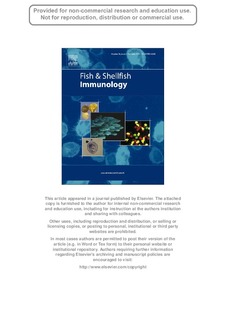| dc.description.abstract | In rainbow trout (Onchorhynchus mykiss) it has been shown that high affinity IgM antibodies havea higher degree of disulfide polymerization and a longer half life time. In the present study, distinct IgMsub-variants related to ancestral tetraploidy in salmonidfish were analyzed to reveal possible charac-teristic differences between these. A monoclonal antibody (MAb4C10) which distinguishes between IgM-A and IgM-B in Atlantic salmon (Salmo salar) and brown trout (Salmo trutta) was further characterized. Itwas shown that substitution of a proline located in the loop between the B and C beta strands of the thirdconstant domain (m3) of salmonmA eliminated MAb4C10 reactivity. Accordingly, the reverse substitutionin salmonmB restored MAb4C10 reactivity. Molecular cloning ofmcDNA from arctic char (Salvelinusalpinus) revealed two sub-variants (mA-1 andmA-2), i.e. a similar situation as in Atlantic salmon andbrown trout. However, arctic char IgM eluted in one peak by anion exchange chromatography, in contrastto salmon and brown trout IgM that are eluted in two peaks. The only characteristic residue of salmonand brown troutmB is an additional cysteine in the C-terminal part ofm4. Most likely, this cysteine isinvolved in inter-chain disulfide bonding and influences the elution profiles of IgM-A and IgM-B on anionexchange chromatography. Neither of themsub-variants in arctic char have the additional cysteine, andchar IgM, as well as salmon and brown trout IgM-A, showed a lower degree of inter-chain disulfidebonding than IgM-B when subjected to denaturation and gel electrophoresis under non-reducingconditions. Hybrids of char/salmon expressedmA-1,mA-2,mA andmB, indicating that there are twoparalogous Ig heavy chain gene complexes in the haploid genome of char, like in Atlantic salmon. Acomparison of salmonidmsequences is presented, including representatives ofSalmoninae(trout, salmonand char),Thymallinae(grayling) andCoregoninae(whitefish) | nb_NO |
